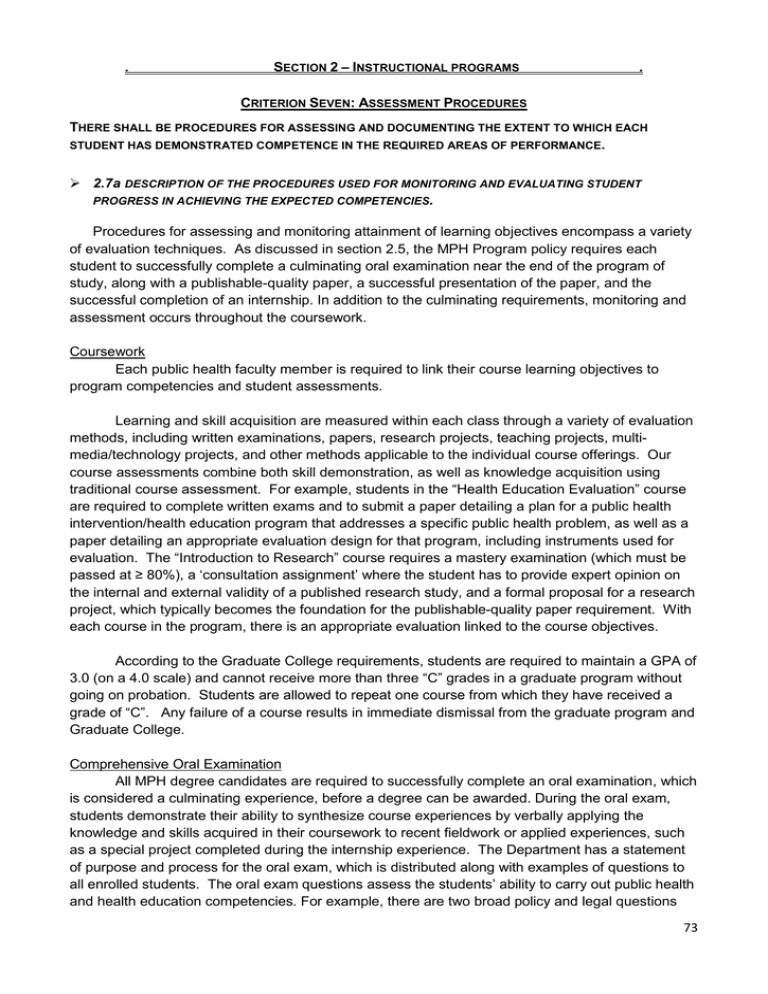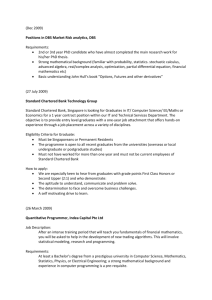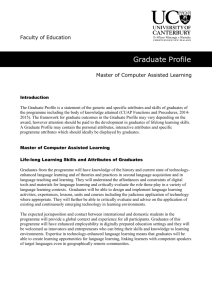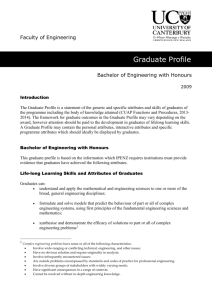Section 2.7_FNL(pp73-78)
advertisement

. SECTION 2 – INSTRUCTIONAL PROGRAMS . CRITERION SEVEN: ASSESSMENT PROCEDURES THERE SHALL BE PROCEDURES FOR ASSESSING AND DOCUMENTING THE EXTENT TO WHICH EACH STUDENT HAS DEMONSTRATED COMPETENCE IN THE REQUIRED AREAS OF PERFORMANCE. 2.7a DESCRIPTION OF THE PROCEDURES USED FOR MONITORING AND EVALUATING STUDENT PROGRESS IN ACHIEVING THE EXPECTED COMPETENCIES. Procedures for assessing and monitoring attainment of learning objectives encompass a variety of evaluation techniques. As discussed in section 2.5, the MPH Program policy requires each student to successfully complete a culminating oral examination near the end of the program of study, along with a publishable-quality paper, a successful presentation of the paper, and the successful completion of an internship. In addition to the culminating requirements, monitoring and assessment occurs throughout the coursework. Coursework Each public health faculty member is required to link their course learning objectives to program competencies and student assessments. Learning and skill acquisition are measured within each class through a variety of evaluation methods, including written examinations, papers, research projects, teaching projects, multimedia/technology projects, and other methods applicable to the individual course offerings. Our course assessments combine both skill demonstration, as well as knowledge acquisition using traditional course assessment. For example, students in the “Health Education Evaluation” course are required to complete written exams and to submit a paper detailing a plan for a public health intervention/health education program that addresses a specific public health problem, as well as a paper detailing an appropriate evaluation design for that program, including instruments used for evaluation. The “Introduction to Research” course requires a mastery examination (which must be passed at ≥ 80%), a ‘consultation assignment’ where the student has to provide expert opinion on the internal and external validity of a published research study, and a formal proposal for a research project, which typically becomes the foundation for the publishable-quality paper requirement. With each course in the program, there is an appropriate evaluation linked to the course objectives. According to the Graduate College requirements, students are required to maintain a GPA of 3.0 (on a 4.0 scale) and cannot receive more than three “C” grades in a graduate program without going on probation. Students are allowed to repeat one course from which they have received a grade of “C”. Any failure of a course results in immediate dismissal from the graduate program and Graduate College. Comprehensive Oral Examination All MPH degree candidates are required to successfully complete an oral examination, which is considered a culminating experience, before a degree can be awarded. During the oral exam, students demonstrate their ability to synthesize course experiences by verbally applying the knowledge and skills acquired in their coursework to recent fieldwork or applied experiences, such as a special project completed during the internship experience. The Department has a statement of purpose and process for the oral exam, which is distributed along with examples of questions to all enrolled students. The oral exam questions assess the students’ ability to carry out public health and health education competencies. For example, there are two broad policy and legal questions 73 which require students to concisely and coherently describe the role of policy development and public health law in the implementation of a public health intervention. The MPH Program Manual provides information to MPH students along with a statement of purpose and the processes involved (see MPH Program Manual for details of the oral examination and oral exam questions). Three faculty members serve as examiners for the MPH oral exam. Once the exam is completed, the student is excused and the faculty members immediately deliberate the given student’s performance and determine a grade for the oral examination. Two out of three faculty members must provide a grade of ‘pass’ in order for the student to pass the oral exam. Once the faculty members have come to a decision, the faculty and student partake in a brief facultyexaminee conference regarding the student's performance. The possible grades and the resulting consequences are as follows: Pass: The Graduate College is notified that the student has successfully completed this requirement for award of the MPH degree. Pass with Written Remediation: The student did not perform satisfactorily on one or two exam questions and has been given a written assignment to complete. Once the student has demonstrated mastery of the material through this written assignment, the Graduate College is notified that the student has successfully completed this requirement for award of the MPH degree. Fail: The student did not perform satisfactorily on more than two questions in the oral exam. The student is provided feedback and is given areas of improvement. A second oral exam is scheduled. The Graduate College is notified once the student has successfully completed this requirement for award of the MPH degree. If the student fails the oral exam twice, the student is dismissed from the MPH Program. Publishable-Quality Paper The publishable-quality paper requirement has become a multi-step process that typically takes 6 to 2 months from start to completion. The publishable-quality paper requirement is designed for students to show the skills involved in the analytic assessment and the communication competencies. In addition, the task of developing lessons and recommendations as a result of their research allows students to demonstrate policy competencies. Students initially meet and discuss their research topic with faculty individually to determine the optimal faculty to serve as chair. Based on these meetings, the student selects a paper topic and publishable-quality paper chairperson. The student then develops a formal proposal that is submitted to the Paper Chairperson and a Second Reader. The proposal becomes a working document by which the student completes the proposed research. Should the student be unable to carry through the proposed research, a new paper proposal must be submitted and approved by the two faculty members. The Second Reader is typically a second public health faculty member but can be another faculty member at ESU. The function of the Second Reader is to provide additional expertise (i.e., statistical consults, IRB application consults, content/intervention consults, etc.) and oversight of the process (see the MPH Program Manual and Appendix 8 for Publishable-Quality Paper Proposal Guidelines and Policies). Internship Internship evaluation guidelines are detailed in the MPH Internship Manual (Appendix 7). Supervision of interns is a joint responsibility of the Agency Supervisor and Faculty Supervisor. 74 Interns are evaluated on the following criteria: health education skills, management capabilities, leadership abilities, and general knowledge. In addition, interns are required to complete a special project (e.g., planning and implementation of an educational program, public health intervention, or completion of a needs assessment/evaluation/research project). The intern must file a regular weekly log/report to the Faculty Supervisor. This report includes a daily schedule of activities, learning experiences, suggestions to agency/supervisor, overall weekly progress, and general comments in which the student is asked to reflect on the link between the internship experiences and the coursework student learning objectives. The intern is also required to complete an internship notebook describing events and experiences encountered during the professional fieldwork. The intern notebook should include information about the host agency, including organizational charts, philosophy, goals, facility data, program pamphlets, and other pertinent information. For the full-time internship, the agency supervisor evaluates each intern midway through the internship (at the completion of 150 hours) and at the completion of the internship (≥ 300 hours). Faculty internship supervisors consider the evaluation procedures to be extensive and comprehensive. Student tasks and responsibilities are clearly delineated for the student and the agency, eliminating confusion. The MPH Internship Manual is updated/revised frequently. A strength of the evaluation includes providing the intern the opportunity to evaluate the agency. This not only helps the program maintain a pool of internship sites that will ensure future internship experiences that help accomplish the MPH Program goals, but it also allows students to analyze organizational and management structures, policies and practices. Students who have completed internships have provided feedback that is, for the most part, very positive regarding well-structured internships and useful onsite supervision. Students have also reported that agency staff have had favorable impressions of the Faculty Supervisor’s in the overall internship placement. 2.7.b IDENTIFICATION OF OUTCOMES THAT SERVE AS MEASURES BY WHICH THE PROGRAM WILL EVALUATE STUDENT ACHIEVEMENT IN EACH DEGREE PROGRAM, AND PRESENTATION OF DATA ASSESSING THE PROGRAM’S PERFORMANCE AGAINST THOSE MEASURES FOR EACH OF THE LAST THREE YEARS. The goals and objectives for the program include various outcome measures on students and graduates that are synthesized from surveys. All the program objectives are provided in Section 1.2; however, Table 2.7.b.1 describes the outcomes relevant to student assessment. TABLE 2.7.b.1: Student Assessment Outcomes Program-Level Objectives Measure 2009 2010 2011 100% 100% 95% All graduates will successfully complete and present a publishable-quality research 100% paper. 100% 100% 100% (8) 100% (20) All graduates will develop research-related competencies as listed in the MPH Program competency list. All graduates will receive a minimum of a 3.0 in all research-related coursework. The program will graduate 8 students per year. The program will graduate 8 students per year. 100% (18) 75 Program-Level Objectives Measure All graduates will demonstrate All graduates will receive a 3.0 or better in attainment in all domains of all coursework. the program competencies for public health practice. All graduates will demonstrate attainment in all domains of the program competencies for public health practice. All graduates will demonstrate their public health practice competency through successful completion of their oral examination. All graduates will demonstrate their capacity to design, develop and conduct applied research that contributes to public health education practice. All graduates will successfully complete a supervised internship, as per supervisor and preceptor evaluations. 2009 2010 2011 100% 100% 100% 100% 100% 100% 100% 100% 100% All graduates will successfully complete a 100% research-based publishable-quality paper. 100% 100% All graduates will demonstrate All graduates will successfully present their capacity to present their publishable-quality paper. research orally. 100% 100% 100% All graduates who take the CHES exam will pass. 100% pass rate 100% 100% 100% Graduates will be employed at the level appropriate to their education and experience in a position that contributes to population-based public health. Graduates’ employment history will be documented on regular surveys. Rates of employment in areas that contribute to population-based public health will be recorded. 100% NA 89% 2.7.C DEGREE COMPLETION RATES AND JOB PLACEMENT EXPERIENCE. As reported in our 2009-10 annual report, of the 35 students starting the program, 22 graduated, six withdrew, and seven continued beyond the 4.0-year criterion. As shown in table 2.7.c.1, our graduation rate dropped to 63% in 2010, which is below the 80% criteria set by CEPH. TABLE 2.7.c.1: Degree Completion Rates Percent of students completing within four academic years. 2009 2010 2011 87%* 63% 80% * The initial 2009 graduation rate reported was 59% but that was based on the percentage of students able to graduate in four semesters. However, we changed the denominator from 4 to 8 semesters to accommodate the reality that many of our part-time students have been unable to complete the program in two years (within fall, spring, and summer terms). In addition, the University has limited the tuition covered by graduate assistantships to 9 credits for four semesters which will extend the number of semesters need to complete graduate programs. The University requires graduate students to complete all graduate coursework for a given graduate degree in 12 semesters, however the MPH program set the standard at eight semesters. 76 Of the six students withdrawing, two were international students who returned to their country of origin due to personal issues (i.e., family health; family business commitments). Another two students discontinued due to affordability problems that occurred due to layoffs from their work. One part-time student decided to transfer her six credits from ESU to the University of Massachusetts (UMass) online program in ‘Public Health Practice’. Her work schedule became unpredictable and she felt the online program at UMass would be a more feasible path for her to complete her degree. The last student who discontinued took a job offer from a hospital in the Washington, DC area. There were seven students continuing, who did not complete their MPH degree in the 4.0-year time frame. Two students who were on a military service grant were suddenly deployed to another region of the country for training needed to prepare for their tour of duty in Iraq. It is unclear as to whether they will return; although, they both wish to do so. Three students have requested leaves of absence due to work constraints, along with work instability. Due to employers’ layoffs, these three students were asked to work longer hours along with a lack of clarity as to whether their positions would remain stable. One student requested a leave due to affordability issues, as her employer no longer provided tuition reimbursement. It is unclear whether this student will return given the loss of this benefit, and the increasing costs of out of state tuition at ESU. The final student who requested leave did so due to a pregnancy. The MPH Program outcome for employment, “graduates will be employed at the level appropriate to their education and experience in a position that contributes to population based public health”, has not been assigned a specific measurement process but can be qualitatively derived based on graduate employment data. Table 2.7.c.2 indicates that our graduates typically find employment within 6 months of graduation, and table 2.7.d.1 below indicates this employment is mostly within the non-profit sector or with local/state/federal organizations. Recently, we have witnessed an increasing number of alumni being hired by healthcare systems. This trend is likely due to hiring shifts seen as a function of healthcare reform. Over the last seven years, about three out of 20 of alumni (~15%) continue on to doctorate programs, medical school, or residency programs. TABLE 2.7c.2: Employment Information of Recent MPH Graduates Employed 6 Months after Graduation 2007 N=19 2009 N=39 2011 N=33 Yes 100% 100% 89% No 0% 0% 11% 2.7.d EMPLOYMENT DESTINATIONS OF MPH GRADUATES 2009-2011 TABLE 2.7.d.1:Sectors of Employment for MPH Program Graduates Place of Employment 2009 2010 2011 Nonprofit Agency 13% 29% 17% 38% 14% 21% 0% 0% 0% 0% 24% 22% County/State or Federal Government Public Health Agency Local/State/Federal Government Agency (other than public health) Healthcare System or Network 77 For Profit Health Care 13% 0% 6% University or College 13% 0% 17% Non-Health Field 0% 14% 0% Continuing Education (i.e., doctorate; medical school; residency) 25% 14% 17% 2.7.e IN PUBLIC HEALTH FIELDS WHERE THERE IS CERTIFICATION OF PROFESSIONAL COMPETENCE, DATA ON THE PERFORMANCE OF THE PROGRAM’S GRADUATES ON THESE NATIONAL EXAMINATIONS FOR EACH OF THE LAST THREE YEARS. TABLE 2.7.e.1: CHES Pass Rate Program-Level Objective All graduates who take the CHES exam will pass. Measure 100% pass rate 2009 100% 2010 100% 2011 100% Note: these do not represent total of all graduates. 2.7.f DATA DESCRIBING RESULTS FROM PERIODIC ASSESSMENTS OF ALUMNI AND EMPLOYERS OF GRADUATES REGARDING THE ABILITY OF THE PROGRAM’S GRADUATES TO EFFECTIVELY PERFORM THE COMPETENCIES IN A PRACTICE SETTING. Although historically the MPH Program has not conducted employer interviews, recently the program added an additional assessment through which we conduct these types of interviews. In these employer interviews, we ask employers of our alumni (≤ 2 years post-graduation) to provide strengths and weakness of our alumni relevant to our program competencies. We expect to have these data available in a resource room. 2.7.g ASSESSMENT OF THE EXTENT TO WHICH THIS CRITERION IS MET. This criterion is met with commentary. Our MPH Program has a series of thorough, welldefined student assessment policies and procedures. Student-related program objective measures remain strong, and student outcomes are being achieved. For the most part, our graduation rates are good; although, on a number of occasions students needed to take a semester off to save funds to continue or switch to part-time status. Despite the significant cuts to the regional public health infrastructure, our employment data are positive. The assessment of our competencies could be strengthened. RECOMMENDATION: Continual assessment of student-related program objectives and outcomes needs to emphasize any illuminated areas of concern. Development of a process to assess the program’s link to alumni employment will be strengthened over the next year. The internship needs to provide students with a more direct link or greater opportunity for reflection between internship experiences and competencies. In addition, the program needs to strengthen its assessment of alumni by conducting bi-annual interviews of employers. 78





